Zhan Chen
Towards Economical Inference: Enabling DeepSeek's Multi-Head Latent Attention in Any Transformer-based LLMs
Feb 20, 2025Abstract:Multi-head Latent Attention (MLA) is an innovative architecture proposed by DeepSeek, designed to ensure efficient and economical inference by significantly compressing the Key-Value (KV) cache into a latent vector. Compared to MLA, standard LLMs employing Multi-Head Attention (MHA) and its variants such as Grouped-Query Attention (GQA) exhibit significant cost disadvantages. Enabling well-trained LLMs (e.g., Llama) to rapidly adapt to MLA without pre-training from scratch is both meaningful and challenging. This paper proposes the first data-efficient fine-tuning method for transitioning from MHA to MLA (MHA2MLA), which includes two key components: for partial-RoPE, we remove RoPE from dimensions of queries and keys that contribute less to the attention scores, for low-rank approximation, we introduce joint SVD approximations based on the pre-trained parameters of keys and values. These carefully designed strategies enable MHA2MLA to recover performance using only a small fraction (0.3% to 0.6%) of the data, significantly reducing inference costs while seamlessly integrating with compression techniques such as KV cache quantization. For example, the KV cache size of Llama2-7B is reduced by 92.19%, with only a 0.5% drop in LongBench performance.
UNetMamba: An Efficient UNet-Like Mamba for Semantic Segmentation of High-Resolution Remote Sensing Images
Aug 26, 2024



Abstract:Semantic segmentation of high-resolution remote sensing images is vital in downstream applications such as land-cover mapping, urban planning and disaster assessment.Existing Transformer-based methods suffer from the constraint between accuracy and efficiency, while the recently proposed Mamba is renowned for being efficient. Therefore, to overcome the dilemma, we propose UNetMamba, a UNet-like semantic segmentation model based on Mamba. It incorporates a mamba segmentation decoder (MSD) that can efficiently decode the complex information within high-resolution images, and a local supervision module (LSM), which is train-only but can significantly enhance the perception of local contents. Extensive experiments demonstrate that UNetMamba outperforms the state-of-the-art methods with mIoU increased by 0.87% on LoveDA and 0.36% on ISPRS Vaihingen, while achieving high efficiency through the lightweight design, less memory footprint and reduced computational cost. The source code is available at https://github.com/EnzeZhu2001/UNetMamba.
UNetMamba: Efficient UNet-Like Mamba for Semantic Segmentation of High-Resolution Remote Sensing Images
Aug 21, 2024



Abstract:The semantic segmentation of high-resolution remote sensing images plays a crucial role in downstream applications such as urban planning and disaster assessment. However, existing Transformer-based methods suffer from the constraint between accuracy and efficiency. To overcome this dilemma, we propose UNetMamba, a novel Mamba-based semantic segmentation model. It incorporates a Mamba Segmentation Decoder (MSD) that can efficiently decode the complex information within high-resolution images, and a Local Supervision Module (LSM), which is train-only but can significantly enhance the perception of local contents. Extensive experiments demonstrate that UNet-Mamba outperforms the state-of-the-art methods with the mIoU increased by 0.87% on LoveDA and 0.36% on ISPRS Vaihingen, while achieving high efficiency through light weight, low memory footprint and low computational cost. The source code will soon be publicly available at https://github.com/EnzeZhu2001/UNetMamba.
Secrets of RLHF in Large Language Models Part II: Reward Modeling
Jan 12, 2024



Abstract:Reinforcement Learning from Human Feedback (RLHF) has become a crucial technology for aligning language models with human values and intentions, enabling models to produce more helpful and harmless responses. Reward models are trained as proxies for human preferences to drive reinforcement learning optimization. While reward models are often considered central to achieving high performance, they face the following challenges in practical applications: (1) Incorrect and ambiguous preference pairs in the dataset may hinder the reward model from accurately capturing human intent. (2) Reward models trained on data from a specific distribution often struggle to generalize to examples outside that distribution and are not suitable for iterative RLHF training. In this report, we attempt to address these two issues. (1) From a data perspective, we propose a method to measure the strength of preferences within the data, based on a voting mechanism of multiple reward models. Experimental results confirm that data with varying preference strengths have different impacts on reward model performance. We introduce a series of novel methods to mitigate the influence of incorrect and ambiguous preferences in the dataset and fully leverage high-quality preference data. (2) From an algorithmic standpoint, we introduce contrastive learning to enhance the ability of reward models to distinguish between chosen and rejected responses, thereby improving model generalization. Furthermore, we employ meta-learning to enable the reward model to maintain the ability to differentiate subtle differences in out-of-distribution samples, and this approach can be utilized for iterative RLHF optimization.
HeightFormer: A Multilevel Interaction and Image-adaptive Classification-regression Network for Monocular Height Estimation with Aerial Images
Oct 12, 2023



Abstract:Height estimation has long been a pivotal topic within measurement and remote sensing disciplines, proving critical for endeavours such as 3D urban modelling, MR and autonomous driving. Traditional methods utilise stereo matching or multisensor fusion, both well-established techniques that typically necessitate multiple images from varying perspectives and adjunct sensors like SAR, leading to substantial deployment costs. Single image height estimation has emerged as an attractive alternative, boasting a larger data source variety and simpler deployment. However, current methods suffer from limitations such as fixed receptive fields, a lack of global information interaction, leading to noticeable instance-level height deviations. The inherent complexity of height prediction can result in a blurry estimation of object edge depth when using mainstream regression methods based on fixed height division. This paper presents a comprehensive solution for monocular height estimation in remote sensing, termed HeightFormer, combining multilevel interactions and image-adaptive classification-regression. It features the Multilevel Interaction Backbone (MIB) and Image-adaptive Classification-regression Height Generator (ICG). MIB supplements the fixed sample grid in CNN of the conventional backbone network with tokens of different interaction ranges. It is complemented by a pixel-, patch-, and feature map-level hierarchical interaction mechanism, designed to relay spatial geometry information across different scales and introducing a global receptive field to enhance the quality of instance-level height estimation. The ICG dynamically generates height partition for each image and reframes the traditional regression task, using a refinement from coarse to fine classification-regression that significantly mitigates the innate ill-posedness issue and drastically improves edge sharpness.
HVDetFusion: A Simple and Robust Camera-Radar Fusion Framework
Jul 21, 2023



Abstract:In the field of autonomous driving, 3D object detection is a very important perception module. Although the current SOTA algorithm combines Camera and Lidar sensors, limited by the high price of Lidar, the current mainstream landing schemes are pure Camera sensors or Camera+Radar sensors. In this study, we propose a new detection algorithm called HVDetFusion, which is a multi-modal detection algorithm that not only supports pure camera data as input for detection, but also can perform fusion input of radar data and camera data. The camera stream does not depend on the input of Radar data, thus addressing the downside of previous methods. In the pure camera stream, we modify the framework of Bevdet4D for better perception and more efficient inference, and this stream has the whole 3D detection output. Further, to incorporate the benefits of Radar signals, we use the prior information of different object positions to filter the false positive information of the original radar data, according to the positioning information and radial velocity information recorded by the radar sensors to supplement and fuse the BEV features generated by the original camera data, and the effect is further improved in the process of fusion training. Finally, HVDetFusion achieves the new state-of-the-art 67.4\% NDS on the challenging nuScenes test set among all camera-radar 3D object detectors. The code is available at https://github.com/HVXLab/HVDetFusion
Contrastive Learning from Spatio-Temporal Mixed Skeleton Sequences for Self-Supervised Skeleton-Based Action Recognition
Jul 07, 2022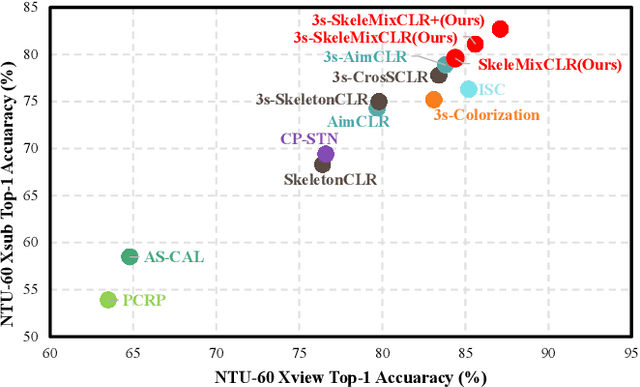
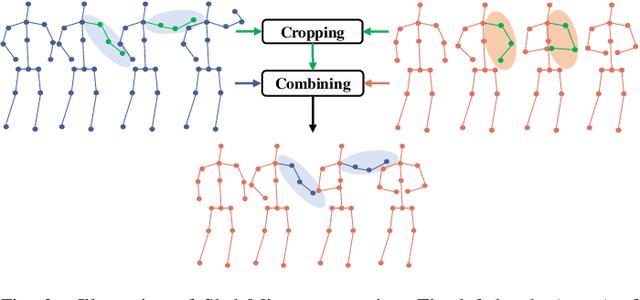

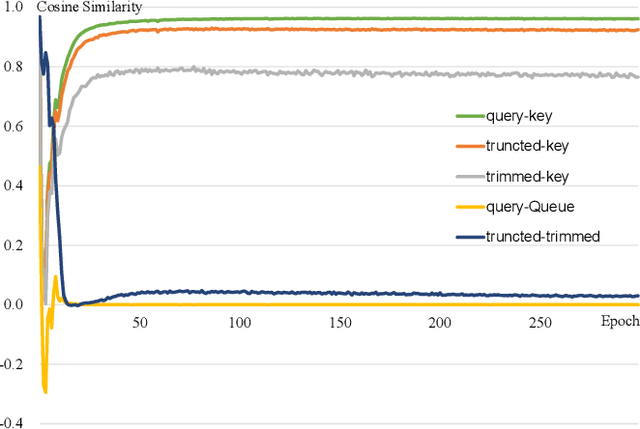
Abstract:Self-supervised skeleton-based action recognition with contrastive learning has attracted much attention. Recent literature shows that data augmentation and large sets of contrastive pairs are crucial in learning such representations. In this paper, we found that directly extending contrastive pairs based on normal augmentations brings limited returns in terms of performance, because the contribution of contrastive pairs from the normal data augmentation to the loss get smaller as training progresses. Therefore, we delve into hard contrastive pairs for contrastive learning. Motivated by the success of mixing augmentation strategy which improves the performance of many tasks by synthesizing novel samples, we propose SkeleMixCLR: a contrastive learning framework with a spatio-temporal skeleton mixing augmentation (SkeleMix) to complement current contrastive learning approaches by providing hard contrastive samples. First, SkeleMix utilizes the topological information of skeleton data to mix two skeleton sequences by randomly combing the cropped skeleton fragments (the trimmed view) with the remaining skeleton sequences (the truncated view). Second, a spatio-temporal mask pooling is applied to separate these two views at the feature level. Third, we extend contrastive pairs with these two views. SkeleMixCLR leverages the trimmed and truncated views to provide abundant hard contrastive pairs since they involve some context information from each other due to the graph convolution operations, which allows the model to learn better motion representations for action recognition. Extensive experiments on NTU-RGB+D, NTU120-RGB+D, and PKU-MMD datasets show that SkeleMixCLR achieves state-of-the-art performance. Codes are available at https://github.com/czhaneva/SkeleMixCLR.
Boosting R-CNN: Reweighting R-CNN Samples by RPN's Error for Underwater Object Detection
Jun 28, 2022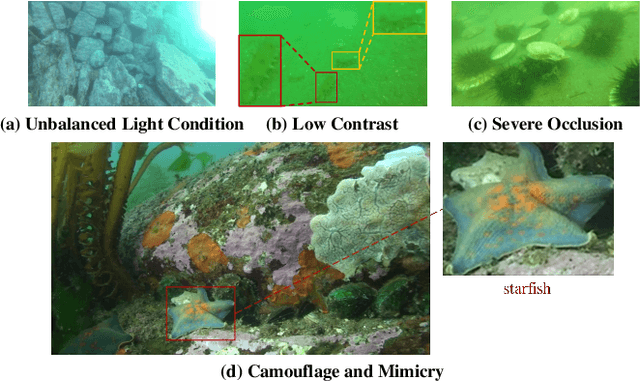
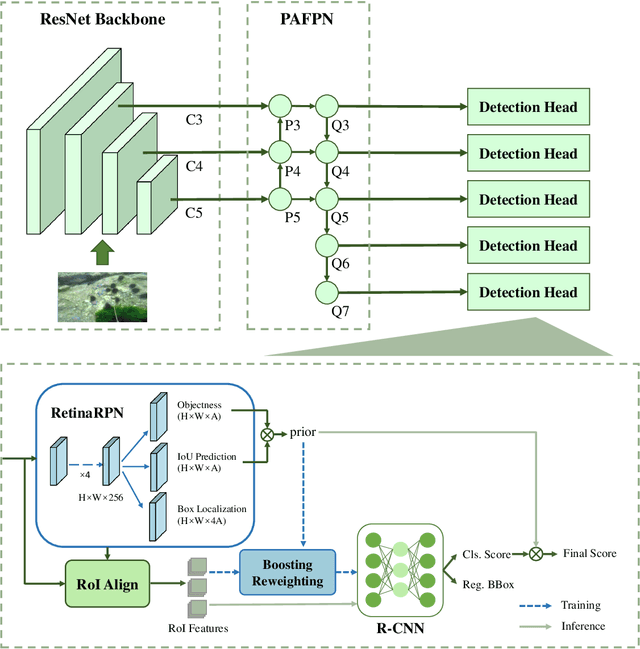
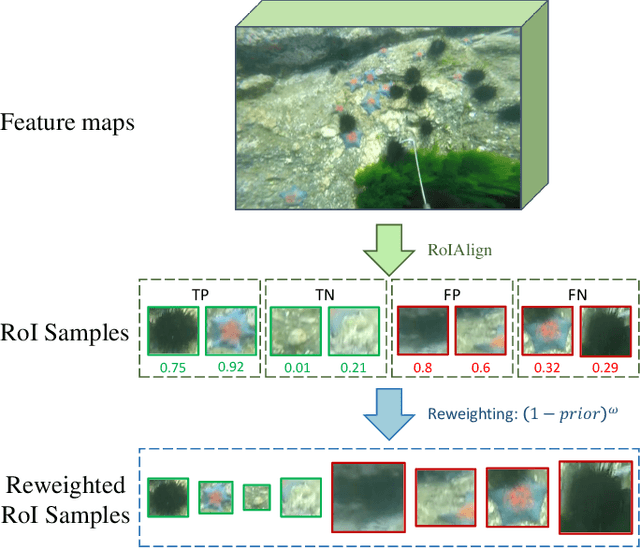
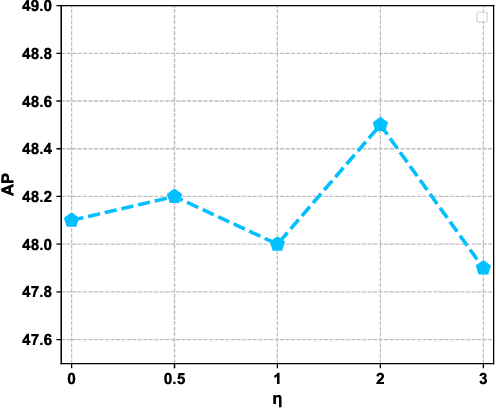
Abstract:Complicated underwater environments bring new challenges to object detection, such as unbalanced light conditions, low contrast, occlusion, and mimicry of aquatic organisms. Under these circumstances, the objects captured by the underwater camera will become vague, and the generic detectors often fail on these vague objects. This work aims to solve the problem from two perspectives: uncertainty modeling and hard example mining. We propose a two-stage underwater detector named boosting R-CNN, which comprises three key components. First, a new region proposal network named RetinaRPN is proposed, which provides high-quality proposals and considers objectness and IoU prediction for uncertainty to model the object prior probability. Second, the probabilistic inference pipeline is introduced to combine the first-stage prior uncertainty and the second-stage classification score to model the final detection score. Finally, we propose a new hard example mining method named boosting reweighting. Specifically, when the region proposal network miscalculates the object prior probability for a sample, boosting reweighting will increase the classification loss of the sample in the R-CNN head during training, while reducing the loss of easy samples with accurately estimated priors. Thus, a robust detection head in the second stage can be obtained. During the inference stage, the R-CNN has the capability to rectify the error of the first stage to improve the performance. Comprehensive experiments on two underwater datasets and two generic object detection datasets demonstrate the effectiveness and robustness of our method.
Multi-Scale Spatial Temporal Graph Convolutional Network for Skeleton-Based Action Recognition
Jun 27, 2022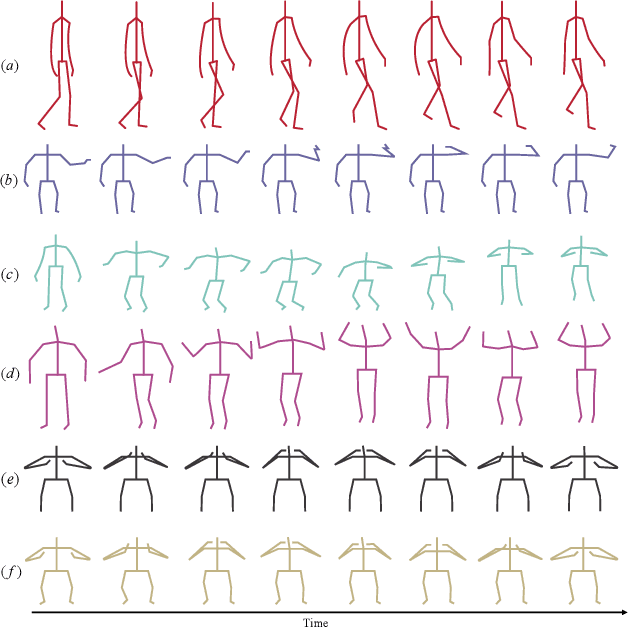
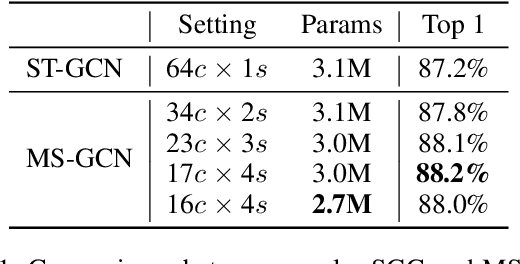
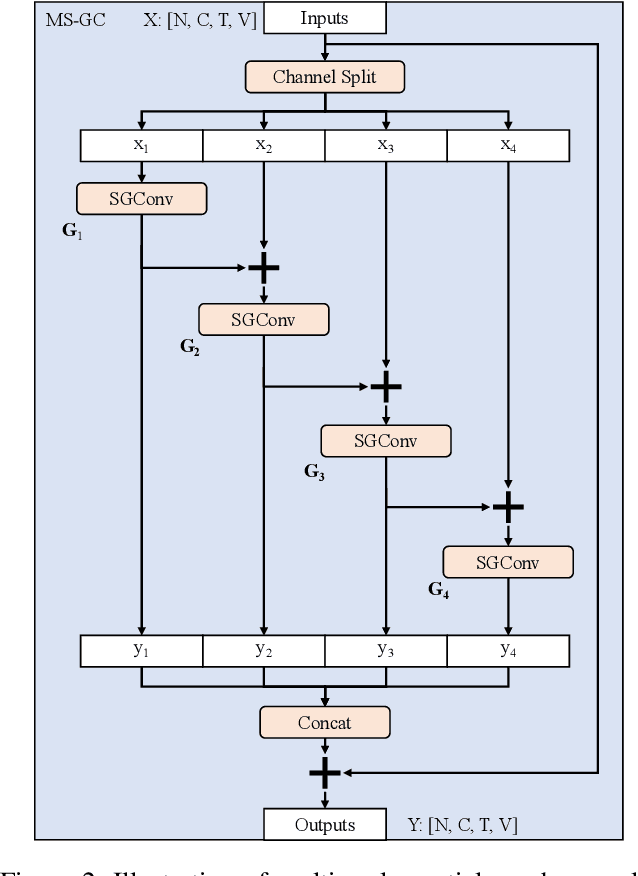
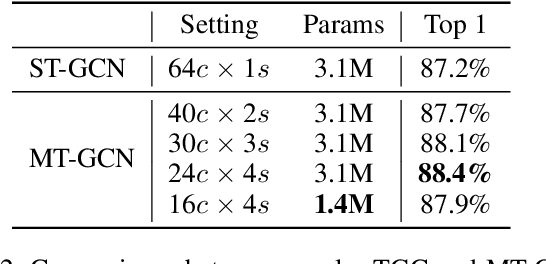
Abstract:Graph convolutional networks have been widely used for skeleton-based action recognition due to their excellent modeling ability of non-Euclidean data. As the graph convolution is a local operation, it can only utilize the short-range joint dependencies and short-term trajectory but fails to directly model the distant joints relations and long-range temporal information that are vital to distinguishing various actions. To solve this problem, we present a multi-scale spatial graph convolution (MS-GC) module and a multi-scale temporal graph convolution (MT-GC) module to enrich the receptive field of the model in spatial and temporal dimensions. Concretely, the MS-GC and MT-GC modules decompose the corresponding local graph convolution into a set of sub-graph convolution, forming a hierarchical residual architecture. Without introducing additional parameters, the features will be processed with a series of sub-graph convolutions, and each node could complete multiple spatial and temporal aggregations with its neighborhoods. The final equivalent receptive field is accordingly enlarged, which is capable of capturing both short- and long-range dependencies in spatial and temporal domains. By coupling these two modules as a basic block, we further propose a multi-scale spatial temporal graph convolutional network (MST-GCN), which stacks multiple blocks to learn effective motion representations for action recognition. The proposed MST-GCN achieves remarkable performance on three challenging benchmark datasets, NTU RGB+D, NTU-120 RGB+D and Kinetics-Skeleton, for skeleton-based action recognition.
Contrastive Learning from Extremely Augmented Skeleton Sequences for Self-supervised Action Recognition
Dec 07, 2021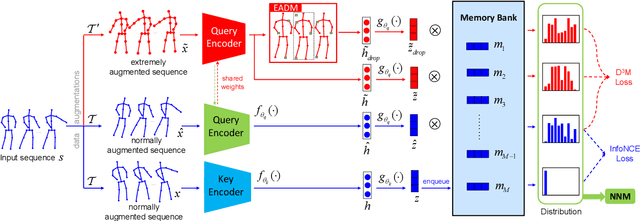
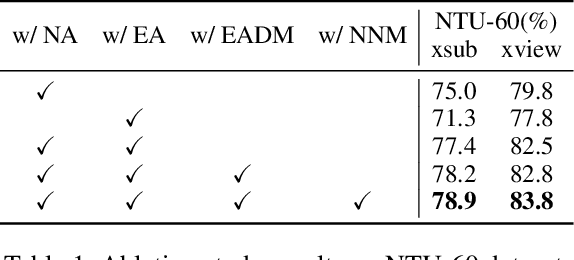
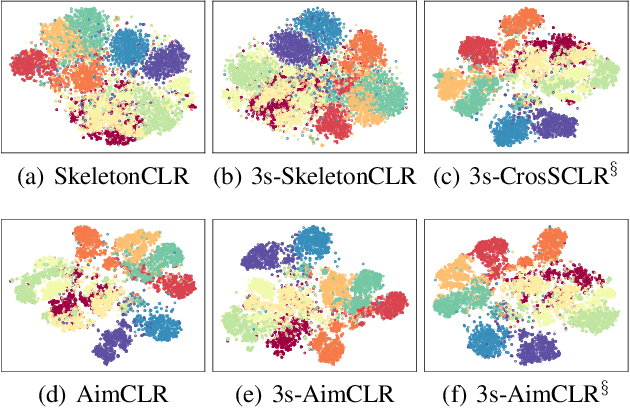

Abstract:In recent years, self-supervised representation learning for skeleton-based action recognition has been developed with the advance of contrastive learning methods. The existing contrastive learning methods use normal augmentations to construct similar positive samples, which limits the ability to explore novel movement patterns. In this paper, to make better use of the movement patterns introduced by extreme augmentations, a Contrastive Learning framework utilizing Abundant Information Mining for self-supervised action Representation (AimCLR) is proposed. First, the extreme augmentations and the Energy-based Attention-guided Drop Module (EADM) are proposed to obtain diverse positive samples, which bring novel movement patterns to improve the universality of the learned representations. Second, since directly using extreme augmentations may not be able to boost the performance due to the drastic changes in original identity, the Dual Distributional Divergence Minimization Loss (D$^3$M Loss) is proposed to minimize the distribution divergence in a more gentle way. Third, the Nearest Neighbors Mining (NNM) is proposed to further expand positive samples to make the abundant information mining process more reasonable. Exhaustive experiments on NTU RGB+D 60, PKU-MMD, NTU RGB+D 120 datasets have verified that our AimCLR can significantly perform favorably against state-of-the-art methods under a variety of evaluation protocols with observed higher quality action representations. Our code is available at https://github.com/Levigty/AimCLR.
 Add to Chrome
Add to Chrome Add to Firefox
Add to Firefox Add to Edge
Add to Edge